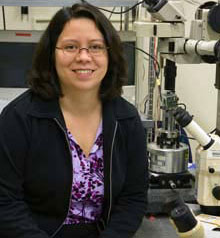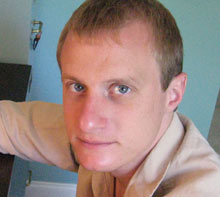UC Berkeley Press Release
Scientists honored for scientific and technological innovation
BERKELEY – Two young University of California, Berkeley, scientists have been recognized by Technology Review magazine as among the world's top innovators under age 35. Chemical engineer Rachel A. Segalman was chosen for developing a novel way to generate electricity from heat and J. Christopher Anderson for designing tumor-killing bacteria.
In addition, the recipient of the magazine's 2007 Humanitarian of the Year, Tapan Parikh, has accepted an appointment at UC Berkeley's School of Information, effective January 2008. He was honored for using mobile phones to transform microfinance in rural India.
Another UC Berkeley scientist, long-time professor of chemistry Alex Pines, was named last month one of R&D Magazine's top 100 innovators of the year for a development in the area of magnetic resonance imaging that could eliminate the need for powerful magnets.
The annual "TR35" list was announced Wednesday, Aug. 15, by Technology Review, the oldest technology magazine in the world and a publication of the Massachusetts Institute of Technology (MIT). The 35 innovators on the list were selected from more than 300 nominees as examples of "the spirit of innovation in business, technology and the arts," according to the magazine.
"The TR35 honors young innovators for accomplishments that are poised to have a dramatic impact on the world as we know it," said Jason Pontin, the magazine's editor-in-chief and publisher. "We celebrate their success and look forward to their continued advancement of technology in their respective fields."
Segalman, Anderson and the other TR35 winners for 2007 will be featured in the September issue of the magazine and honored at the Emerging Technologies Conference to be held at MIT Sept. 25-27.
 Rachel Segalman |
Rachel Segalman, 31, the Charles Wilke Assistant Professor of Chemical Engineering at UC Berkeley, aims to create polymers that automatically assemble into a desired structure, such as a flexible plastic sheet that produces energy from sunlight. Though these so-called functional polymers have many uses in the energy field, her main goal is to characterize how these polymers work alone and together, in particular, how changing the chemical structure affects their electronic characteristics.
While working with single molecules, she and her colleagues discovered that heating the ends of a polymer to different temperatures generates a voltage, opening the door to using heat differences to generate electrical power. Though the voltages produced so far are small, she is collaborating with UC Berkeley mechanical engineering professor Arun Majumdar to mix composites and nanocrystals together to make thermoelectric devices that perhaps will be able to scavenge waste heat for power.
Segalman's main research is "defining how the thermoelectric and electronic properties change as we change the chemical structure of materials is very important as we start to design more devices," she said. "What chemistries we really need inside to make a good photovoltaic relies on that question."
"The nice thing about molecules is the possibility of changing their structure to increase the amount of thermal power almost infinitely," she added. "There is a lot of work to go before we understand what chemical structure really works for that to happen. It's an exciting and intriguing question."
 J. Christopher Anderson |
J. Christopher Anderson, 31, a post-doctoral researcher in the laboratory of UC Berkeley bioengineering professor Adam Arkin and in the campus's Synthetic Biology Engineering Research Center, or SynBERC, has plugged a half dozen groups of genes into a benign variety of E. coli bacteria to create a microbe that can zero in on a tumor and kill it. The project, soon to move into animal trials, pushes the limits of the field of synthetic biology, and goes far beyond the genetically engineered bacteria used to date to target tumors.
"These bacteria are more complex, with a larger number of introduced genes, than anything people have tested in animals," Anderson said, noting that he and his colleagues have increased the bacteria's genome by more than 1 percent.
Each group of genes allows the bacteria to do something bacteria don't normally do. One group of genes allows the bacteria to evade the immune system, one senses the low-oxygen environment of a tumor, another facilitates invasion of the cell, while another releases a poison inside the cell to kill it. Anderson hopes to add even more functions to the engineered bacteria.
"The real potential of synthetic biology is that you can keep adding functions to make the tumor killer better, bigger and more effective," he said. "We're nowhere near the limits of how much DNA the bacteria can hold."
At least three of the awardees on the TR35 list come from the ranks of synthetic biology, two of them having obtained their Ph.D.s from the laboratory of synthetic biology guru Jay Keasling, head of SynBERC, professor of chemical engineering at UC Berkeley and head of the synthetic biology department at Lawrence Berkeley National Laboratory (LBNL). Kristala Jones Prather, 34, an assistant professor of chemical engineering at MIT, was named to the list for developing a promising reverse-engineering strategy for synthesizing commercial molecules biologically. Neil Renninger, 33, cofounder and now senior vice president for development of Amyris Biotechnologies, was named for applying synthetic-biology to the production of biofuels.
 Tapan Parikh (Brian Smale photo, courtesy of Technology Review) |
Tapan Parikh, 33, is a doctoral student in computer science at the University of Washington and the founder of a company called Ekgaon Technologies. Parikh has created information systems based on the ubiquitous mobile phone for small-business people in the developing world. This system will help business owners get money to expand their operations, for example, and perhaps find better prices for what they sell.
With the software Parikh developed, called Cam because the phone's camera plays a key role in the user interface, it becomes simple to use phones to capture images and scan documents, enter and process data, and run interactive audio and video. Parikh's most important project with Cam has focused on microfinance, in which lending groups grant tiny loans - on the order of $25 - to people in the developing world, usually to fund small-business ventures. Parikh is convinced that mobile phones have the capability to become far more powerful tools, and he has other applications in mind for Cam, such as tracking disease outbreaks and improving the coordination of relief after disasters.
"I'm pretty excited, but trying to take it in stride," Parikh said in an e-mail. "This is a recognition of promise and potential - which means that most of the work is still ahead! It is a tremendous opportunity to be able to undertake that with the students and colleagues I will have at Berkeley."
 Alex Pines |
Alex Pines, a faculty scientist at LBNL, is a leading expert on magnetic resonance imaging (MRI) and the basic technique underlying MRI: nuclear magnetic resonance (NMR). MRI and NMR take advantage of the fact that molecules in a magnetic field reveal their environment when zapped with radio waves. Chemists use the technique to discover the conditions inside a liquid or solid, while doctors use it to distinguish between tissues in the body.
The need for a large and powerful magnet and expensive support systems limits MRI's use, however, and this spurred Pines to invent innovative ways of improving the information obtainable from nuclear magnetic resonance while decreasing the size of the magnet. Pines and his colleagues won the award for laser-detected MRI - a major breakthrough that eliminates the need for a high-field magnet, making the technology accessible to new users and applications.
This new technology could soon enable MRI to image a wide range of phenomena, from petroleum reservoirs and other samples to very small objects such as tissue samples and microfluidics. In contrast to a typical high-field MRI system that might cost $1 million and weigh 10,000 pounds, the so-called Laser-Detected MRI might sell for $30,000 and weigh less than 100 pounds. Pines' colleagues include LBNL scientists Dmitry Budker, also a UC Berkeley associate professor of physics; Marcus Donaldson; Simon Rochester; Shoujun Xu and Valeriy Yashchuk.
Pines will receive a plaque at R&D Magazine's formal awards banquet in Chicago on Oct. 18.
Technology Review Links:

